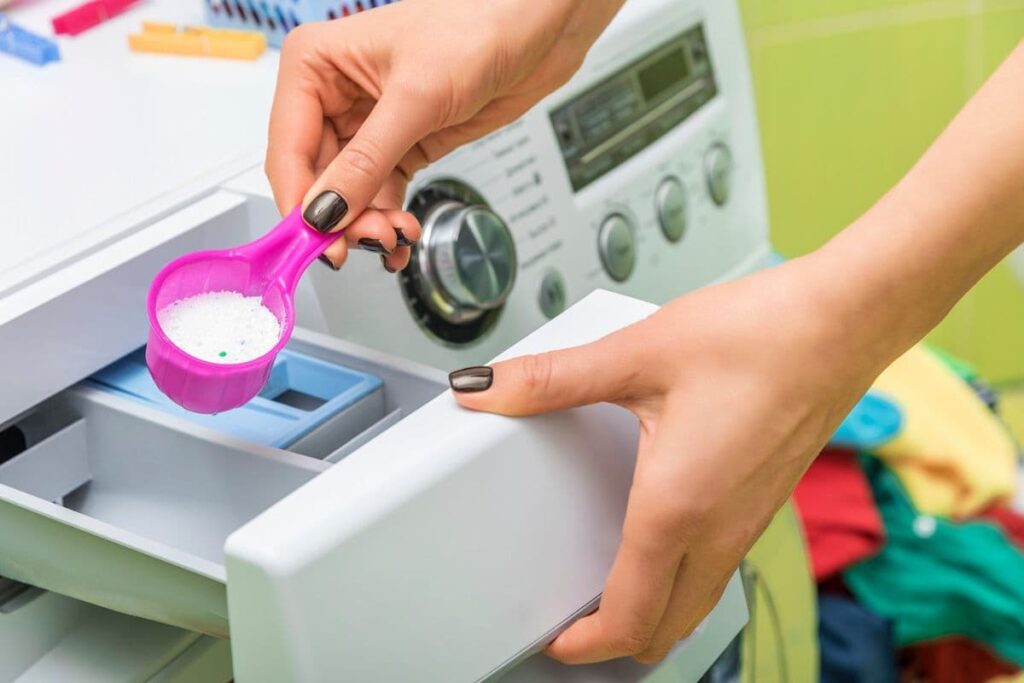A washing machine has three compartments, including the pre-wash, main wash, and softener. The pre-wash is the first compartment, and many washing machine users get confused about whether to use detergents in the pre-wash compartment or not.
A pre-wash detergent is the laundry chemical used in the pre-wash compartment of a washing machine when handling excessively-soiled clothes. While it’s optional, a pre-wash detergent can effectively clean extremely dirty laundry.
This article discusses the pre-wash process, including what can go into the pre-wash compartment. Keep reading.

What Is a Pre-wash Detergent?
Prewash detergents go in the pre-wash detergent compartment, usually labeled “i” or “1.” However, using detergents in the pre-wash cycle isn’t always necessary, as you can complete the pre-wash cycle without using detergent or a stain remover.
As the pre-wash stage is meant to loosen deep stains in clothes before they undergo the main wash, only deeply-soiled clothes require detergents during prewash. Nevertheless, you can always use detergent to prewash clothes, deeply soiled or not, provided you use a small amount.
Because the pre-wash cycle is short and takes 3-5 minutes to complete, the excess detergent does more harm than good to your washing process. The clothes take longer to rinse, especially in the pre-wash stage.
So, if you must use pre-wash detergents, use moderate quantities.
Is Pre-wash the Same as Detergent?
Prewash is the same as detergent. You don’t need special detergent in the prewash stage, as normal detergent will suffice. The only difference between the detergent you use in the prewash and main wash stages is the amount, which should be proportional to your laundry’s excess dirt.
The pre-wash and main-wash stages in modern washing machines are similar. Think of the pre-wash stage not as a unique process that needs special detergent but as an extra stage to deal with potentially-troublesome dirt.
The same process occurs in both stages.
If you use the pre-wash stage, the machine will do more work on your clothes, making it more likely that difficult stains will be removed successfully.
You can use the pre-wash stage without detergent. Your clothes will receive an extra rinse and, depending on the extent of dirt, that may be the only extra attention they need to be clean.
Afterward, they’ll go through the main-wash stage.
Whether to use detergent in the pre-wash stage and how much detergent to use depends on how excessively dirty your laundry is. If it needs only a little extra attention, a detergent-free rinse in the pre-wash stage will do.
If you’re dealing with properly soiled laundry, you are better off using detergent.
Can You Put Bleach in Pre-wash?
You can’t put bleach in pre-wash, mainly because it’s too short of a stage, but you can use bleach in the main wash cycle. The best way to use bleach in your washing machine is as soon as the rinse cycle begins.
By then, the detergent has done its job, and the bleach can go in for the final cleaning and strengthening of your fabric.
People usually feel the need to do too much for clothes with deep stains, which may cause them to ruin their fabric. Washing machines have a separate dispenser for bleach, and you’re advised not to put the bleach directly in your washer.
If you feel your white clothes need extra cleaning and bleach, putting bleach in the pre-wash may not make the difference you think it would. The pre-wash cycle is usually over in 3-5 minutes, which is not enough time for the bleach to work on your clothes.
You may want to soak your clothes in cold or hot water before pre-washing them, depending on the type of fabric you’re dealing with. Do this before pre-washing with detergent or stain remover.
Soaking clothes before putting them in the washing machine significantly loosens stains, allowing the bleach to complete the work easily.
Do I Put Detergent in Pre-wash or Main Wash?
You can put detergent in the pre-wash and the main wash. While you can do without detergent in the pre-wash stage, the main wash needs detergent to clean your clothes.
Since the pre-wash is usually complete in a short timeframe, the key thing your clothes need to loosen stains is water, not excessive use of detergent. People sometimes assume that the pre-wash is where most dirt removal happens.
However, this is wrong. The pre-wash is the foundation for the washing process, which means that you can avoid detergent and opt for a simple rinse.
You may even skip the pre-wash cycle while doing your laundry, although it’s good for your clothes that you don’t. On the other hand, the main wash stage is essential to the laundry process.
The pre-wash cycle prepares the clothes and makes them easier to clean, which can be done without detergent. On the other hand, the main wash cycle is where the dirt and stain removal work happens, which is why detergent is crucial unless you’re willing to experiment with alternatives to laundry detergent.
What Is the Pre-wash Symbol?
The pre-wash symbol is usually “I” or “1,” which is often the first compartment before the main wash labeled “2” or “II.” The softener compartment has a flower symbol.
Identifying the pre-wash symbol is essential to using the pre-washing stage. For example, you can’t put detergent in the main wash compartment and expect it to work in the pre-wash stage.
The detergent in the detergent compartment “i” or “1” is specifically for the pre-wash cycle. An empty detergent compartment means that you’re pre-washing with water alone which is fine.
Conclusion
Pre-washing your clothes loosens stains before the main wash cycle, giving you cleaner clothes. Detergents and stain removers are not a necessity for your pre-wash cycle.
Each compartment in your washing machine serves a distinct purpose, and they all work together to clean your clothes. If you’re unfamiliar with modern washing machines, take some time to study all the features, including the pre-wash cycle, to get the best out of your machine.





